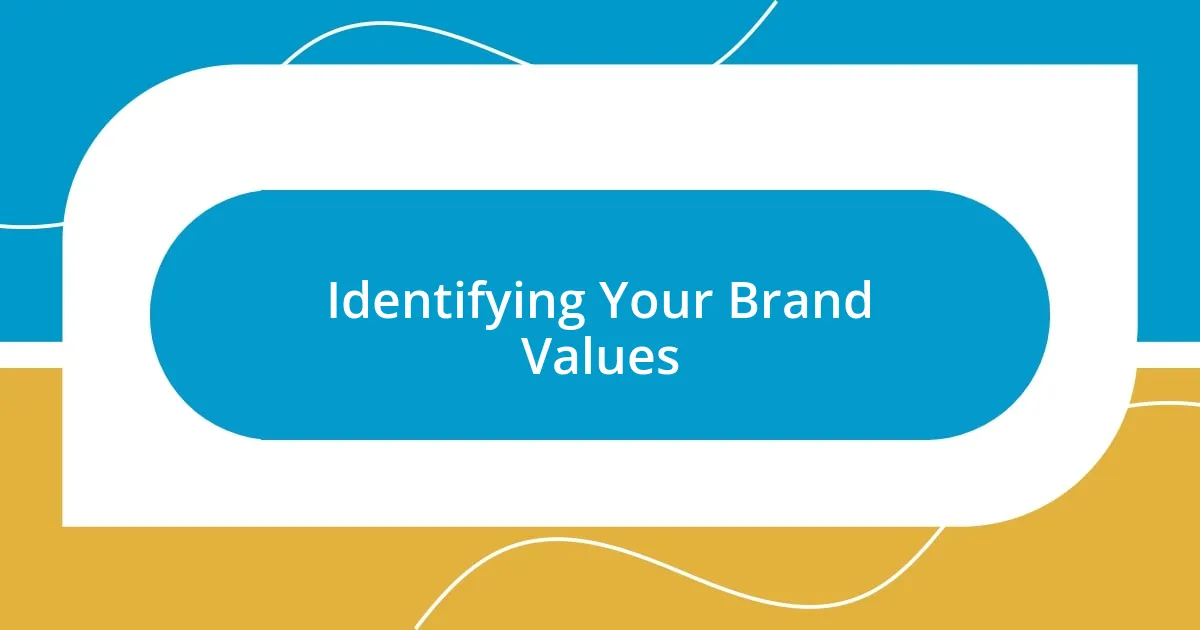Key takeaways:
- Color psychology significantly influences audience emotions and perceptions, impacting branding choices and effectiveness.
- Aligning color selections with brand values creates authenticity and fosters deeper connections with your target audience.
- Understanding demographics, cultural influences, and psychographics is crucial in tailoring color choices that resonate with consumers.
- Consistent branding and evaluating color effectiveness through testing can lead to improved brand recognition and emotional engagement.

Understanding Color Psychology
Color psychology is fascinating because it taps into the emotions and perceptions that colors evoke within us. For instance, have you ever noticed how a bright orange can make you feel energized? I remember a time when I walked into a café painted in soft pastel shades, and I instantly felt relaxed. The soothing blues and greens created a calm atmosphere, affecting my mood and prolonging my stay.
When selecting colors for branding, it’s crucial to consider what feelings you want to elicit from your audience. I’ve always found that red often grabs attention and conveys excitement—think of festive occasions or promotions. Yet, too much red can cause anxiety, so I aim for balance. Could the colors of your brand evoke the right emotional responses? I often reflect on how different hues can connect deeply with audiences, often based on cultural or personal experiences.
The subtleties within color choices also play a significant role. For example, I chose a muted yellow for a project intended for a children’s charity, feeling it radiated warmth and optimism. This decision wasn’t random; instead, it was a deliberate attempt to foster a sense of hope and joy. Have you ever thought about how the shades you like can reveal your own emotional landscape? Colors are not just visual—they resonate on a deeper emotional level, influencing how we interact with the world around us.

Identifying Your Brand Values
Identifying your brand values requires deep introspection and a clear understanding of what your brand stands for. I remember taking time to pen down my core values, realizing that they significantly shape my branding decisions. This process brought clarity; for example, if a brand values sustainability, green tones might reflect that dedication effectively. Isn’t it interesting how the essence of what you believe in can manifest visually?
As I aligned my colors with my brand values, I found that they served as a compass for every decision in my branding journey. When I set out to launch my travel blog, prioritizing adventure and curiosity led me to vibrant blues and earthy tones, which embodied exploration and connection with nature. Choosing colors that resonate with your values can help establish an authentic connection with your audience, right?
Creating a visual expression of your brand’s values is essential for effective branding. The experiences we encounter shape our perceptions, and aligning the colors with your values ensures cohesion. I once worked with a local bakery whose warmth and community focus came alive through rich browns and golds. The colors told a story of homemade goodness and togetherness, demonstrating the power of thoughtful color selection in branding.
| Brand Value | Suggested Color |
|---|---|
| Sustainability | Green |
| Adventure | Blue |
| Warmth | Brown |
| Creativity | Purple |

Researching Your Target Audience
Understanding your target audience is a crucial step in choosing colors for branding. It’s not just about what looks good; it’s about what resonates with the people you want to attract. I recall a project where I delved into customer surveys and social media analytics. The insights I gathered about preferences and emotional triggers were eye-opening. It became clear that a youthful audience responded positively to bright and playful hues, while a more mature demographic preferred subdued and classic tones.
To effectively tailor your color choices, consider these factors:
- Demographics: Age, gender, and location can influence color perception.
- Cultural Influences: Colors may have different meanings across cultures, impacting audience connection.
- Psychographics: Interests, values, and lifestyles can dictate color preferences that feel authentic.
- Industry Trends: Researching competitors can reveal successful color schemes already appealing to your audience.
By investing time in understanding your audience, you can create a visual identity that truly connects with them. For instance, during a branding consultation, I discovered that an eco-conscious audience gravitated towards earthy tones. I adjusted the color palette accordingly, and the response was overwhelmingly positive. Engaging with your audience’s preferences opens doors to deeper emotional connections, which can transform brand loyalty.

Creating a Color Palette
Creating a cohesive color palette is like crafting a visual symphony that resonates with your audience. I’ve had moments where choosing a specific hue felt as instinctual as picking my favorite book off the shelf. For instance, when I was developing branding for a wellness brand, I gravitated towards serene blues and soft pastels. These colors evoked a sense of tranquility and balance, which perfectly aligned with the brand’s mission of promoting holistic well-being. Isn’t it fascinating how a color can evoke particular feelings?
As I gathered colors for my palette, I focused on the interplay between them. Too many clashing hues can overwhelm, while a harmonious arrangement invites curiosity. I remember a project where I paired deep greens with muted grays. This combination created a grounded yet sophisticated look, subtly reflecting the brand’s commitment to sustainability without being overbearing. How do you want your audience to feel when they see your brand?
I often refer back to my color-wheel explorations, which remind me of art class in school. Using complementary colors can enhance visual impact, bringing to life an idea I’ve always held: contrast emphasizes the message. During my time working on a startup’s branding, I used pops of orange against darker tones, evoking excitement and energy. That little spark made such a difference! I would encourage you to play around with colors, feeling them out until something clicks—because, at the end of the day, your colors should tell a story that feels as authentically you as the brand itself.

Testing Colors in Branding
Testing colors in branding is an essential step that I often find both exciting and revealing. When I launched a new product line, I decided to test three distinct color variations through A/B testing on social media ads. The outcome was striking—while the soft teal generated a solid engagement, the bold coral captured attention far more effectively, compelling me to rethink my initial preference. This process highlighted how sometimes, the colors you instinctively favor might not resonate as well as alternatives you haven’t fully considered.
One of the most effective methods I’ve used is gathering feedback through surveys and focus groups. It’s a straightforward yet powerful approach. I once invited a diverse group of individuals to review potential branding colors for a tech startup. Their insights were illuminating; they could articulate why certain colors felt innovative or trustworthy, enhancing my understanding of emotional responses tied to specific hues. I learned that colors evoke emotions and, when properly tested, can guide the audience’s perception of a brand.
In my experience, the balance between personal preference and audience response can be tricky. I vividly remember a time when I was adamant about using a vibrant yellow for a food brand, believing it represented freshness. However, after testing it with my target audience, I discovered that many associated it with caution instead. It reminded me of the importance of stepping outside my comfort zone and being open to insights from real users. Have you ever had a color that you loved but didn’t quite work with your audience? It’s a humbling experience, yet an incredibly valuable lesson in color psychology.

Implementing Consistent Branding
Implementing consistent branding is like weaving a tapestry that reflects your brand’s essence. I remember when I decided on a signature color for my own consultancy; each project I’ve tackled since echoes that choice. This clarity has allowed clients to recognize my work instantly, creating a sense of familiarity and trust. Have you noticed how powerful consistent colors can be in establishing recognition?
Equally crucial is how I incorporate these colors into every facet of my brand—my website, social media graphics, and even email signatures. I once revamped my marketing materials, diligently ensuring that every shade remained true to my chosen palette. The result? A more cohesive message that felt both polished and professional. It felt like I was showing up as my authentic self with every interaction. Isn’t it incredible how that visual language speaks volumes?
Moreover, I make a point of revisiting my brand’s color applications regularly. During a recent review, I realized that though my colors remained unchanged, my messaging had slightly shifted over time. Refreshing old designs with those familiar hues not only revitalized my content but also reminded my audience of my mission. Have you taken the time to look at how your colors tell your brand’s story? Keeping that coherence alive allows your brand to evolve while still remaining instantly recognizable.

Evaluating Brand Color Effectiveness
Evaluating the effectiveness of color in branding has been a fascinating journey for me. I vividly recall when I was working on a campaign for a wellness brand and tested various shades of green. Initially partial to a dark forest green, I switched to a refreshing mint after recognizing it resonated more strongly with consumers’ feelings of calm and rejuvenation. Have you ever considered how a color change can radically shift public perception?
The feedback we gathered from online polls and social media reactions was eye-opening. It was intriguing to see how specific colors elicited loyalty—for example, a vibrant blue evoked trust, while a bright orange sparked enthusiasm. As I delved deeper, I couldn’t help but feel a sense of responsibility; every color choice is a statement and brings certain expectations. How does that weigh on you when you choose your brand colors?
Looking back, I’ve learned it’s essential not just to count conversions but to read between the lines. One poignant moment came when a long-time client shared how their customers felt more ‘connected’ after they updated their palette. It reminded me that evaluating color effectiveness is not just about metrics; it’s about emotional resonance. Have you experienced that connection where a subtle change made a significant difference in how people perceive what you do? It’s a powerful reminder to always tune into the emotional undertones of your branding.














